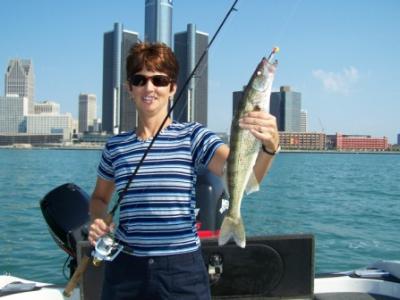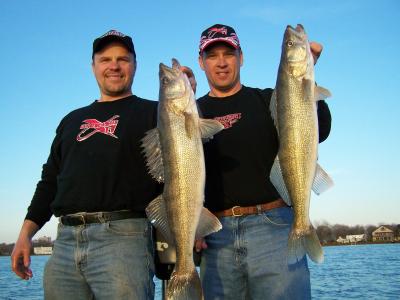If you are looking for some early spring walleye fishing then the Detroit River is the place to be. When the rest of Ontario is still waiting for the ice to melt and walleye season to open the river becomes a hotspot. Having fished the Detroit River for almost 20 years and operating Chartertalk Guide Service since 1999, I have guided many from across the midwestern states to personal bests and trophy fish.
Anglers from the midwestern states converge on the river looking at a chance to land a trophy walleye. While the Detroit River is well known across the US, most of Ontario seems to be unaware of the great fishing opportunities that exists in the local area. The Detroit River connecting Lake St. Clair to the north and Lake Erie to the south also have great bass and musky fishing as well.
Located in southwestern Ontario separating Michigan and Ontario. The Detroit River is a 30 mile walleye factory that produces great catches of spring walleyes. There are a number of fish weighing in over 10 lbs every spring. During the months of April and May walleyes from Lakes Erie and St.Clair migrate to the Detroit River to spawn.
The north end of the river from Peche Island to the Ambassador Bridge is an urban area with homes, parks and city buildings in the background. The lower half is filled with smaller islands and a mix of wilderness, homes and large industrial parks.
Best fishing is done from a boat. Most boats are 14-18 foot aluminums with an electric trolling motor to control the current, which is difficult to tame for newcomers. Boat control is the name of the game here. With good boat control on the right day you can catch a limit of walleyes in one drift. Or you can sit on those fish and hammer them all day long. Other days you will fight to scratch out a limit only to find out just down or up river the guys pounded them. Fish are usually biting on a river, where they are biting can be more difficult. I usually set up a milk run looking for active fish.
How to stay vertical can be a challenge. The wind is blowing one way and the current is taking your boat the other. To solve this simply put your Minn Kota into the wind and use short bursts of power to chase your fishing line. This usually takes a good day or better just learning how to chase your jig. Now combine boat control with jigging at the same time and you could look like somebody walking and chewing gum. That is why going with someone experienced is important.
Vertical jigging is the most common technique used to catch walleyes. Being vertical also prevents numerous snags, which can be found on the river bottom. The north end near Peche Island is relatively snag free, and more snags can be found south of the Ambassador Bridge.
For many spinning gear is the preferred choice. I use a 6'medium action Shimano Compre CPS-60MA rod with a Shimano Stradic 1000 series reel. For fishing line many who have fished the river for years like bright coloured line. Berkley Fireline 8 or 10# test in Flame Green is the choice of many. Fireline has very little stretch and is great for hooksets. The colour is also easy on the your eyes. As a fishing guide I am always looking back to see if my guests lines are vertical.
Where to fish is quite easy. Where they are biting is the other question. Many start where they see a group of boats. Fishing is sometimes done in tight quarters and at times you will think that you are playing bumper boats.
For the most part you will be able to determine if the walleyes are biting quicker in a group of boats. There are no secret spots on the Detroit River many of the best locations have already been discovered and if fish are biting, boats will be there. Some spots include Peche Island, St. Rose Bay, Reaume Park(Pillette Park), Hiram Walkers and the Casino.
Further downriver you can fish the many spots around Fighting Island. Some may have seen these locations while I was fishing with Pete Bowman of the Fishn'Canada Show.
Most fishing is done in 12-30 feet of water on the edges of the shipping channels. Some other interesting spots include warm water discharges that are both natural and man made.
The weight of a jig will vary depending on depth but an assortment of jigs from 3/8 to oz in various colours is necessary. Keeping in contact with the bottom is a must. That is not to say drag bottom but make sure you can feel the bottom when you drop your jig.Chartruese seems to be a favourite, others colours that produce fish are blue/white, soccer ball, and firetiger. There are a number of locals that make their own jigs and have a plethora of colours and shapes. One of the best artist is Rick the (Jigman). His work is well known amongst locals. Round jig heads seem to work just fine in all situations. Most anglers now only tip their jigs with plastics. Berkley Power minnows 3" and 4" are great early in the season. As the water temps rise to the mid 40's Power Worms in 4" pumkinseed colour work well. Other plastics used are FINS minnows made by Lunker City in a variety of shades. Tackle used by local fishermen can all be found at Wally's Bait located at 3195 Sandwich St on the west side of Windsor.
Vertical jigging is one of the best ways to catch any fish. Learning to do it correctly on the Detroit River takes a bit of time. Hiring a guide or going with someone who has experience is the best way to learn quickly. Learning to jig is something that has to be felt. There is no real correct way to jig because each day the fish may want a different presentation.
If you are coming from the United States you may want to look at staying in the city of Windsor. Boat ramps in some of the towns neighbouring Detroit can fill up quickly. Although these ramps have parking for many trailers they do fill. Windsor and the town of LaSalle, Ontario have boat launches and are rarely filled. Lakeview Park marina in Windsor is located at the corner of Riverside Drive and Riverdale Avenue. The LaSalle boat launch is located at Laurier Road and Hwy 18.
Another thing to make note of is having a Michigan fishing license. During the spring the Ontario side of the river is subjected to muddy coloured water due to northeast winds on Lake St. Clair. This makes fishing very tough to say the least and many will slide over the border and fish the Michigan side. During these muddy water days handliners will produce better numbers of fish. Handlining is an "old boy" technique that simply produces fish when the water is off coloured.
Walleye fishing continues to be good until the middle of May and then the warm water species begin to show up. Bass and sheepshead seem to take over making walleye fishing tougher.
If you are looking for new waters or to land a personal trophy you can contact myself at Chartertalk Guide Service www.chartertalk.com 519 984-4899.



